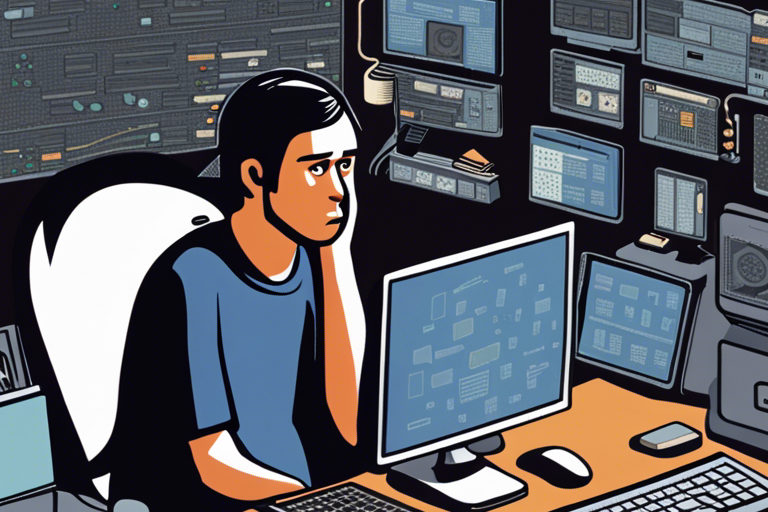1. Installation Challenges
Drawbacks of Linux: Complex Installation Process
Many novice users encounter their first set of challenges with Linux during the installation phase. While seasoned Linux enthusiasts claim the installation process is straightforward, beginners may find themselves entangled in a web of complexities.
Automated installers like those of Ubuntu, Mint, or Fedora can conveniently set up the new OS alongside Windows, keeping all data intact. However, less refined distributions can baffle new users with terminologies like “partitions,” “disk divisions,” “superusers,” and “mounting points,” often without adequate explanations.
An inexperienced user might inadvertently delete essential documents, files, and photos, only to realize post-installation that a bare-bones Linux system is all that remains.
Advanced distributions like Arch Linux require command-line installation. Without a guide, this task can be daunting. Arch users, however, wear this complexity as a badge of honor.
Moreover, many Linux installers teem with minor issues that consistently ruin the user experience. For instance, switching to the English layout after choosing the Cyrillic one in Manjaro is nearly impossible, leading to password entry challenges after a reboot.
Solution: Stick to popular and user-friendly distributions like Ubuntu, Mint, Fedora, openSUSE, or Debian. Always read the Linux installation guide before tinkering with your computer and remember to backup your data regularly.
2. Overwhelming Number of Distributions
Drawbacks of Linux: A Plethora of Distributions
While Windows offers Home and Pro versions and macOS comes as a single, unified OS, Linux presents users with hundreds of different distributions—over 700 at last count. For newcomers, deciding which one to install can be a herculean task.
Linux enthusiasts often engage in spirited debates about the superiority of their preferred distributions. A novice can easily get lost in this sea of choices and, worse, may end up choosing an exotic distribution riddled with hidden issues, potentially souring their Linux experience forever.
Moreover, the compatibility issues between different distributions mean that a favorite program might not work when switching from one Linux distribution to another.
The abundance of distributions also disperses developer efforts. Rather than collaborating to perfect popular solutions, developers often focus on creating their unique Linux versions, exacerbating fragmentation.
Solution: New users should adhere to renowned and user-friendly distributions like Ubuntu, Mint, Fedora, openSUSE, or Debian, avoiding obscure and exotic variants with limited support and compatibility.
3. Lack of a Universal Software Source
Drawbacks of Linux: Absence of a Standardized Software Source
Linux boasts a vast array of software options. However, the installation methods vary, adding another layer of complexity. There isn’t a universal store or source for all applications, making the process of finding and installing software a bit scattered and inconsistent compared to the more streamlined approaches seen in Windows and macOS.
This lack of standardization can sometimes complicate the user experience, especially for those who are new to the Linux ecosystem and are yet to familiarize themselves with the intricacies of different software repositories and installation procedures.
In essence, while Linux offers an enriching and customizable experience for seasoned users, beginners may find themselves navigating a labyrinth of choices, terminologies, and procedures. With patience and learning, however, the initial complexities can transform into a playground of endless possibilities and customizations, unveiling the true power and flexibility that Linux affords its users.
Finding and installing most applications on Linux is as easy as opening the software store, selecting the desired app, and clicking “Install.” However, it’s not always that smooth – sometimes, the needed software is not available in the repository, and that’s where the adventure begins.
Some apps are installed as Snap packages, others as AppImage, and yet others as Flatpak. All these formats can coexist in a single distribution, leading to a system cluttered with excess files. Even simple apps can end up occupying an undue amount of space.
If the software you need is only available as source code for your distribution, you’ll need to compile it manually – a task daunting for a novice, especially if the software author hasn’t provided step-by-step instructions.
Furthermore, adding a software repository to your distribution can be risky. During a system update, compatibility issues might arise, making the installation of specific older software a challenging task.
**Solution**: Unfortunately, users might have to put up with this mess. Alternatively, switching to Arch Linux can be a consideration, where even rare software is downloadable via the extensive AUR repository, offering a more standardized installation process. However, it comes with its set of complications.
4. The Black Screen of Death
Drawbacks of Linux: The Black Screen of Death
Linux enthusiasts often boast about the absence of the infamous Blue Screen of Death encountered in Windows environments. However, they tend to gloss over Linux’s own version – the “Black Screen of Death” and “Kernel Panic.”
The issue manifests post-installation; you reboot the system and are greeted with a black screen and a blinking cursor, unresponsive to key presses.
In the event of a “Kernel Panic,” the system at least spews out some cryptic text, which could potentially be googled if you manage to jot it down quickly. There are no convenient features like QR codes containing error details, as seen in Windows 10.
Solution: Unlike Windows’ BSOD, Linux’s black screen doesn’t completely freeze the system – there’s often a chance to invoke the console and troubleshoot the OS. However, in most scenarios, it’s easier to reinstall the distribution and restore data from a backup. Hence, always remember the golden rule of regular backups.
5. Lack of a Google Drive Client
Drawbacks of Linux: No Native Google Drive Client
It’s a minor issue but an annoying one. Google seems to have a fondness for Linux. Its employees use a custom OS based on Debian, and Chrome OS is built atop Gentoo Linux. Even Google’s servers run on Linux.
However, if you visit Google Drive, the offered clients are exclusively for Windows and macOS, which is disappointing.
Solution: By entering your account details into the system settings, Google Drive will appear directly in the file manager for most GNOME and KDE distributions, functioning perfectly well.
The catch is the necessity of an internet connection to edit the contents of the cloud storage – offline work and later synchronization is not an option. Those who find this inconvenient might consider transitioning to Dropbox, MEGA, or other services offering Linux clients.
6. Absence of a Unified Interface
Drawbacks of Linux: Lack of a Consistent User Interface
Unlike Windows and macOS, which have consistent interfaces, Linux offers extreme flexibility in customization through various desktop environments. Users can opt for a fast and minimalist experience or a feature-rich, sophisticated look. However, this flexibility can be a double-edged sword, especially for novices.
This variety makes it challenging to provide universal steps to achieve specific tasks. If you’re using GNOME and your friend uses KDE, sharing screenshots or screen recordings won’t help much, as each desktop environment has unique settings, menus, and panels.
Applications designed for one environment can look out of place in another, akin to running a Windows 95 program on Windows 11 – functional but aesthetically jarring.
Solution: For those sensitive to aesthetic inconsistencies, sticking to macOS might be the safer bet. If the desire to switch to Linux is strong, choose a distribution with a polished interface like Linux Mint with Cinnamon or Kubuntu with KDE, and avoid running apps designed for different environments.
7. Hibernate Hurdles
Drawbacks of Linux: Hibernate Issues
Hibernate mode, where the computer saves its RAM content to the hard drive and powers down, is a fantastic feature for quickly powering on/off the system. Regrettably, most Linux distributions have historical challenges with hibernation – it’s either inaccessible or dysfunctional.
Solution: Activating hibernation is possible but might require some effort, with online instructions available for assistance. GNOME users may also need a special extension to enable this feature.
8. Gaming Gaps
Drawbacks of Linux: Limited Game Availability
Recommendations for Linux can be difficult for avid gamers. The limited user base often dissuades game developers from porting their titles to Linux, anticipating unprofitable returns. Consequently, many new titles bypass Linux entirely.
Solution: The gaming issue is gradually resolving, and future prospects for Linux as a gaming platform are brightening. Valve’s new Steam Deck, running on a customized Arch with Proton technology, supports a majority of Windows games on Linux. Tools like Lutris and PlayOnLinux offer similar functionalities, and Steam is readily available for download in most app stores on various distributions.
9. Surplus of Superfluous Software
Drawbacks of Linux: A Plethora of Preinstalled Programs
Installing Linux Mint, Ubuntu, or openSUSE greets users with a menu brimming with assorted icons, not all of which are useful. The inclusion of apps like Calc can be redundant for users uninterested in spreadsheets. Embedding formula editors and database management systems in distributions intended for casual web browsing and occasional gaming can seem excessive.
Solution: Users can consider minimal installations and add only necessary applications or opt for distributions known for a cleaner, bloat-free initial setup. It allows for a personalized, clutter-free experience, ensuring that the system includes only the tools and applications aligning with the user’s specific needs and preferences.
9. The Overabundance of Email Clients
Despite the trend of checking emails via web browsers, Linux distribution creators are adamantly incorporating email clients into the operating systems. It raises a question of necessity and utility.
Another issue is the clutter of obsolete and ineffective applications in the Linux app stores. From outdated text editors, myriad sudoku variants, to obscure, glitchy indie games, these seemingly redundant additions clog the repositories.
Solution: Fortunately, Linux allows users to easily uninstall any preinstalled application with a simple click, offering a cleaner experience compared to Windows. Linux’s minimal installations are a blessing – just tick a box during the installation process, and you’re greeted with a barebones system. You can then manually install only the required applications. As for the outdated software in the repositories, always check the update dates and be selective with your installations.
10. Lack of Specific Software
Drawbacks of OS: Absence of Essential Software
One major obstacle preventing users from migrating to Linux is the absence of specialized professional applications, such as Adobe’s suite (Photoshop, Illustrator, InDesign, Dreamweaver, Premier), Microsoft Office, Final Cut, Wondershare Filmora, and many more.
Although there are free Linux alternatives, they often fall short in terms of capabilities and features. Even for professionals, relearning and adapting to new tool interfaces can be a lengthy and energy-consuming task without guaranteed returns.
Solution: If alternatives like GIMP, Krita, Inkscape, and OpenShot don’t meet your needs and you can’t do without Adobe and Microsoft products, two options are available. First, run the required software through the Wine application. Second, install Windows in VirtualBox, though both methods can be demanding on your computer’s resources.
11. Driver Dilemmas
Drawbacks of OS: Driver Issues
Linux interacts with popular hardware as efficiently as Windows. In most cases, no setup is needed – plug in the peripheral, and it works instantly. If not, open the “Driver Manager” (or its equivalent), enter the admin password, and wait for the system to download and install everything automatically.
However, if you own rare or unsupported hardware, be prepared for long hours of manual reading and terminal operations. In extreme cases, drivers need to be compiled from the source code archives.
For die-hard Linux fans, this can be an enjoyable challenge, akin to a sport. But for users simply wanting their decade-old printer to work, it’s hardly a fun experience.
Solution: Before purchasing new hardware, research its compatibility with Linux to avoid potential driver issues. Ensure that the device has well-supported drivers available to make the integration with the Linux system smooth and hassle-free. This preemptive measure saves time and prevents frustration stemming from hardware incompatibility issues.
12. Frequent Use of the Terminal
Drawbacks of the OS: Regular Need for the Terminal
Modern Linux distributions are far more user-friendly than they were 15 years ago. However, the terminal or command-line interface remains a staple of the operating system.
In some ways, this can be beneficial. For instance, when something in the OS isn’t working as expected, a solution often found on Linux forums like Ask Ubuntu involves a quick fix via the terminal, offering a swifter resolution compared to navigating through menus and settings in Windows.
However, this characteristic can sometimes transform into a hurdle. In situations where straightforward instructions are unavailable, inexperienced users find themselves face-to-face with the intimidating terminal, unable to troubleshoot even by trial and error.
The scenario gets trickier when certain settings within the distribution’s graphical interface are inaccessible and can only be adjusted via the terminal – a realization that might not be immediately apparent.
Additionally, the danger lurks for newcomers who might unwittingly copy a harmful command into the terminal, as suggested in jest by others, potentially leading to data loss or other substantial damage.
Solution: Exercise caution and thoroughly understand the commands before entering them into the terminal. Users should be vigilant and ensure they comprehend the potential impact of the commands to avoid unintended consequences.
Reflection
Linux’s constant evolution has mitigated many of its earlier challenges, yet some intricacies, like the regular need for terminal usage, persist. While the terminal offers powerful tools for customization and troubleshooting, it can also be a double-edged sword, especially for newcomers. The risk of encountering malicious commands underscores the importance of understanding and verifying commands before execution.
On the brighter side, the extensive Linux community is a rich resource for support and learning. Novices can gradually gain expertise, turning perceived drawbacks into opportunities for skill enhancement. As with any technology, awareness and informed utilization are key to optimizing the benefits while minimizing the risks.




Leave a Reply